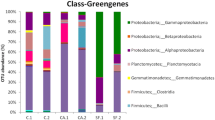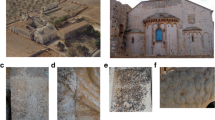Abstract
Among the stone monumental assets, artistic fountains are particularly affected by microbial colonization due to constant contact with water, giving rise to biodegradation processes related with physical–chemical and aesthetical alterations. In this paper, we make an overview of reported biodiversity of the phototrophic patina developed in various fountains of Italy and Spain. The microbial composition of four fountains (two from Florence, Italy and two from Granada, Spain) was investigated using traditional and/or molecular techniques. The results indicated many common similarities with regard the phototrophic biodiversity for all the investigated fountains. Automated ribosomal RNA intergenic spacer analysis (ARISA), a molecular fingerprint tool, was used to examine the eubacterial and cyanobacterial community for two of the investigated fountains. The principal component analysis of ARISA profiles strengthens the results obtained by traditional methods and revealed separate clusters, as a consequence of the differences of micro-environmental conditions for each fountain.







Similar content being viewed by others
References
Barcellona Vero L, Tabasso Laurenzi M (1982) La Fontana del Tritone di L. Bernini, a Roma: un esempio di alterazione legato a fattori chimici, biologici e ambientali. In: Proceedings of 3rd International Congress on the Deterioration and Preservation of Stones, Venezia, 24-27 October 1979, Italy, Istituto di chimica industriale Press, Padova, pp 511–516
Barnett HL (1998) Taxonomy and identification. In: Hunter BB (ed) Illustrated genera of imperfect fungi. APS, Minnessota, pp 6–198
Berrendero E, Perona E, Mateo P (2008) Genetic and morphological characterization of Rivularia and Calothrix (Nostocales, Cyanobacteria) from running water. Int J Syst Evol Microbiol 58:447–460
Bolívar Galiano FC, Sánchez Castillo PM (1997) Biomineralization processes in the fountains of Alhambra, Granada, Spain. Int Biodet Biodegr 40:205–215
Bolívar Galiano FC, Sánchez Castillo PM (1998) Biodeterioro en el Baño de Comares y la Sala de los Abencerrajes en la Alhambra: estudio comparativo. In: Valenciana G (ed) Proceedings of Congreso de conservatión y restauración de bienes culturales. Martin Impresores Press, Alicante, pp 549–553
Bourrelly P (1966) Les algues d’eau douce. N. Boubée&Cie, Paris, pp 1–475
Brehm U, Krumbein WE, Palinska KA (2004) Biomicrospheres generate ooids in the laboratory. Geomicrob J 23:545–550
Cardilli Alloisi L, Di Bella I (1979) La Fontana del Tritone di G.L. Bernini – problemi di restauro e manutenzione. In: Proceedings of 3rd International Congress on the Deterioration and Preservation of Stones, Venezia, 24-27 October 1979, Italy, Istituto di chimica industriale Press, Padova, pp 517–529
Cardinale M, Brusetti L, Quatrini P, Borin S, Puglia AM, Rizzi A, Zanardini E, Sorlinni C, Corselli C, Daffonchio D (2004) Comparison of different primer sets for use in automated ribosomal intergenic spacer analysis of complex bacterial communities. Appl Environ Microbiol 70:6147–6156
Crispim CA, Gaylarde PM, Gaylarde CC (2003) Algal and cyanobacterial biofilms on calcareous historic buildings. Curr Microbiol 46:79–82
Crispim CA, Gaylarde CC, Gaylarde PM (2004) Biofilms on Church walls in Porto Alegre, RS, Brazil, with special attention to cyanobacteria. Int Biodet Biodegr 54:121–124
Edwards U, Rogall T, Blöcker H, Emde M, Böttger EC (1989) Isolation and direct complete nucleotide determination of entire genes. Characterization of a gene coding for 16 S ribosomal RNA. Nuc Acids Res 17:7843–7853
Flores M, Lorenzo J, Gómez-Alarcón G (1997) Algae and bacteria on historic monuments at Alcala de Henares, Spain. Int Biodet Biodegr 40:241–246
Geitler L (1932) Cyanophyceae. In: Akad. Verslagsges (ed) Rabenhorst’s Kryptogamenflora von Deutschland, Österreich und der Schweiz, Johnson Press, Leipzig, 1–1196
Gordon D (2004) Viewing and editing assembled sequences using consed. In: Baxevanis AD, Davison DB (eds) Current protocols in bioinformatics. Wiley, New York, pp 1–43
Hrouzek P, Komarek J, Lukesova A, Mugnai MA, Turicchia S, Ventura S (2005) Diversity of soil Nostoc strains: phylogenetic and morphological variability. Arch Hydrobiol Suppl Algol Stud 117:251–264
Komarek J, Anagnostidis K (1988) Modern approach to the classification system of cyanophytes. Arch Hydrobiol Suppl Algol Stud 53:327–472
Komarek J, Anagnostidis K (1998) Cyanoprokaryota 1. Teil Chroococcales. In: Ettl H, Gärtner G, Heynig H; Mollenhauer D (ed) Süβwasser-flora von Mitteleuropa, Fisher Press, Stuttgart-Jena 19/1:1–548
Komarek J, Anagnostidis K (2005) Cyanoprokaryota 1. Teil Oscillatoriales. In: Büdel B, Gärtner G, Krienitz L, Schageri M (eds) Süβwasser-flora von Mitteleuropa. Elsevier, Munich, pp 1–759
Lamenti G, Tiano P, Tomaselli L (1997) Microbial communities dwelling on marble statues. In: Monte M (ed) Proceedings of the 8th Workshop Eurocare Euromarble EU 496. CNR, Rome, pp 83–87
Lèpere C, Wilmotte A, Meyer B (2000) Molecular diversity of Microcystis strains (Cyanophyceae, Chroococcales) based on 16 S rDNA sequences. Syst Geogr Plants 70:275–283
Ludwig W, Strunk O, Westram R, Richter L, Meier H, Yadhukumar, Buchner A, Lai T, Steppi S, Jobb G, Förster W, Brettske I, Gerber S, Ginhart AW, Gross O, Grumann S, Hermann S, Jost R, König A, Liss T, Lüßmann R, May M, Nonhoff B, Reichel B, Strehlow R, Stamatakis A, Stuckmann N, Vilbig A, Lenke M, Ludwig T, Bode A, Schleifer KH (2004) ARB: a software environment for sequence data. Nuc Acids Res 32:1363–1371
McNamara CJ, Lee KB, Russel MA, Murphy LE, Mitchell R (2009) Analysis of bacterial community composition in concretions formed on the USS Arizona, Pearl Harbor, HI. J Cult Herit 10:232–236
Not R, Miceli G, Terranova F, Catalisano A, Lo Campo P (1995) Indagini sulla natura biotica delle alterazioni. In: Catalisano A, Di Natale R, Gallo E, Vergara F (eds) Fontana Pretoria, studi per un progetto di restauro. Arti Grafiche Siciliane, Palermo, pp 51–63
Nugari MP, Pietrini AM (1997) Trevi Fountain: an evaluation of inhibition effect of water-repellents on cyanobacteria and algae. Int Biodet Biodegr 40:247–253
Ortega-Calvo JJ, Hernandez-Marine M, Saiz-Jimenez C (1993) Cyanobacteria and algae on historic buildings and monuments. In: Garg KL, Garg N, Mukerji KG (eds) Recent advances in biodeterioration and biodegradation. Naya Prokash, Calcutta, pp 174–203
Pietrini AM (1991) Un’indagine conoscitiva sulla microflora. In: Segrete C (ed) Fontana di Trevi, la storia, il restauro. Assessorato alla Cultura, Rome, pp 187–189
Pietrini AM, Ricci S (2005) Fontane e Nimfee. In: Nardini (ed) La biologia vegetale per i beni culturali. Nardini, Florence, pp 189–201
Pruesse E, Quast C, Knittel K, Fuchs B, Ludwig W, Peplies J, Glöckner FO (2007) SILVA: a comprehensive online resource for quality checked and aligned ribosomal RNA sequence data compatible with ARB. Nuc Acids Res 35:7188–7196
Ricci S, Pietrini AM (1994) Characterization of the microfloral algae present on the Fountain of Four Rivers, Rome. In: Fassina V, Ott H, Zezza F (ed) Proceedings of III International Symposium on the Conservation of Monuments in the Mediterranean Basin, Venice, Italy, Soprintendenza ai Beni Artistici e Storici di Venezia Press, pp 353–357
Riding R (2000) Microbial carbonates:the geological record of calcified bacterial-algal mats and biofilms. Sedimentology 47:179–214
Rippka R, Deruelles J, Waterbury JB, Herdman M, Stanier R (1979) Generic assignments, strain histories and properties of pure cultures of cyanobacteria. J Gen Microbiol 111:1–61
Saitou N, Nei M (1987) The neighbor-jointing method: a new method for reconstruction phylogenetic trees. Mol Biol Evol 4:406–425
Sánchez Castillo PM, Bolívar Galiano FC (1997) Caracterización de comunidades epilíticas en fuentes monumentales y su aplicación a la diagnosis del biodeterioro. Limnetica 13:31–46
Sarró MI, García A, Rivalta VM, Moreno DA, Arroyo I (2006) Biodeterioration of the Lions Fountain at the Alhambra Palace, Granada (Spain). Build Environ 41:1811–1820
Taton A, Grubisic S, Brambilla E, De Vit R, Wilmotte A (2003) Cyanobacterial diversity in natural and artificial microbial mats of Lake Fryxell (McMurado Dry Valleys, Antarctica): a morphological and molecular approach. Appl Environ Microb 69:5157–5169
Tomaselli L, Lamenti G, Bosco M, Tiano P (2000) Biodiversity of photosynthethic micro-organisms dwelling on stone monuments. Int Biodet Biodegr 46:251–258
Uher B, Aboal M, Kovacik L (2005) Epilithic and chasmoendolithic phycoflora of monuments and buildings in South-Eastern Spain. Cryptogam Algol 26:275–358
Zurita Peraza Y, Bolívar Galiano FC (2002) Le fontane monumentali dell’Alhambra a Granada. In: Nardini (ed) Kermes, Nardini Press, Florence, pp 63–68
Zurita Peraza Y, Cultrone G, Sánchez Castillo PM, Sebastián E, Bolívar Galiano F (2005) Microalgae associated with deteriorated stonework of the Fountain of Bibatauín in Granada, Spain. Int Biodet Biodegr 55:55–61
Warscheid T, Braams J (2000) Biodeterioration of stone: a review. Int Biodeter Biodegr 46:343–368
Wetherbee R, Lind JL, Burke J (1998) The first-kiss: establishment and control of initial adhesion by raphid diatoms. J Phycol 34:9–15
Acknowledgments
The authors thank F. Bolivar (Faculty of Fine Arts, Univ. of Granada, Spain), The Council of Alhambra and Generalife (Granada, Spain), Florence Municipality, and the management of the Villa la Pietra (Florence, Italy) for their assistance in collecting samples. This work has been made in the frame of the EPISCON Project (MEST-CT-2005-020559—European PhD in Science for Conservation).
Author information
Authors and Affiliations
Corresponding authors
Electronic supplementary material
Below is the link to the electronic supplementary material.
Supplementary Figure 1
Parsimony phylogenetic tree obtained from 16S rRNA gene sequences of cyanobacterial strains isolated from fountains (PDF 11 kb)
Supplementary Figure 2
Maximum likelihood phylogenetic tree obtained from 16S rRNA gene sequences of cyanobacterial strains isolated from fountains (PDF 11 kb)
Supplementary Figure 3
FT-IR spectrum of the white layers observed in the cross-sections of sample S-2 with the characteristic peaks of calcium carbonate (PDF 50 kb)
Supplementary Figure 4
Line plot of accumulated bars. Distribution of the different percentages of fragments in the microbial population of the fountain samples (PDF 59 kb)
Supplementary Table 1
Taxonomic assignment, similarity level, and bootstrap support of cyanobacterial clusters identified in the phylogenetic analysis (PDF 87 kb)
Rights and permissions
About this article
Cite this article
Cuzman, O.A., Ventura, S., Sili, C. et al. Biodiversity of Phototrophic Biofilms Dwelling on Monumental Fountains. Microb Ecol 60, 81–95 (2010). https://doi.org/10.1007/s00248-010-9672-z
Received:
Accepted:
Published:
Issue Date:
DOI: https://doi.org/10.1007/s00248-010-9672-z




